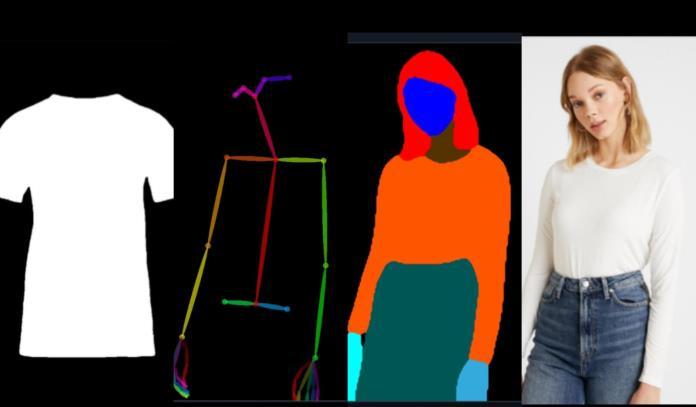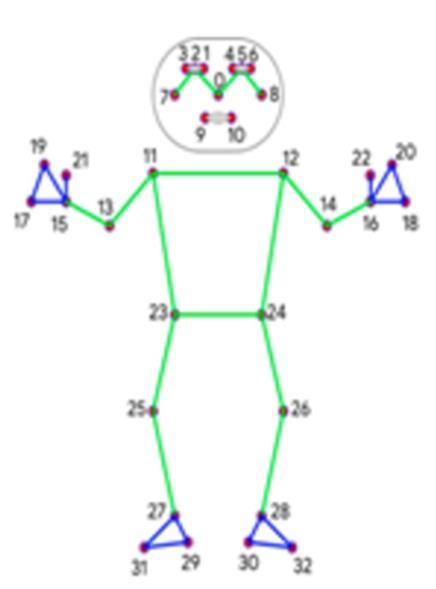
International Research Journal of Engineering and Technology (IRJET) e-ISSN: 2395-0056
Volume: 12 Issue: 05 | May 2025 www.irjet.net p-ISSN: 2395-0072


International Research Journal of Engineering and Technology (IRJET) e-ISSN: 2395-0056
Volume: 12 Issue: 05 | May 2025 www.irjet.net p-ISSN: 2395-0072
Shelke1, Akanksha Awale2, Disha Khose3 , Prof. V M Mhalgi4
1,2,3U.G Student, 4Assistant Professor Department of Computer Science and engineering Shree Tuljabhavani College Of Engineering Tuljapur.
Abstract - Virtual try-on systems have become transformative tools in the fashion and beauty industries, allowinguserstodigitallyexperienceclothing,cosmetics,and accessories before making a purchase. This paper introduces Tryzura, a comprehensive and intelligent virtual try-on framework that leverages advanced machine learning and computer vision technologies to deliver highly realistic and personalized simulations. The system incorporates deep learning techniques for body segmentation, pose estimation, and facial recognition, ensuring precise alignment of garments,accuratemakeuprendering,andseamlessaccessory placement.Byovercomingtechnicalchallengessuchastexture fidelity, color consistency, and user-specific customization, Tryzura creates a smooth and immersive try-on experience. Experimental results on diverse datasets confirm the effectivenessoftheproposedframeworkingeneratinglifelike outputs across a wide range of fashion and beauty products. This work underscores the potential of Tryzura to enhance customer engagement, reduce product returns, and redefine the future of online shopping.
Virtual try-onsystemsarerevolutionizingthefashionand beauty industries by enabling users to digitally preview clothing, makeup, and accessories, fostering a more interactive and personalized shopping experience. This projectpresentsTry-zura,anext-generationvirtualtry-on solution that integrates cutting-edge advancements in computer vision, deep learning, and augmented reality to generate lifelike visualizations of fashion and beauty products. Through sophisticated techniques such as pose estimation, facial mapping, and 3D rendering, Try-zura delivershighlyaccurateandrealisticsimulations,allowing userstoexplorediversestylesandmakeconfident,informed purchase decisions. By tackling critical challenges like fit uncertainty, high return rates, and limited customer engagement, Try-zura significantly elevates the online shopping experience. In addition, it provides substantial value to e-commerce and retail platforms by boosting customer satisfaction and reducing operational overhead. Designedwithperformance,privacy,andscalabilityinmind, Tryzurastandsasareliableandfuture-readysolutionforthe evolvingdigitalcommercelandscape.
The clothing engine within Try-zura transforms digital shoppingintoaninteractive,lifelikeexperiencebyutilizing real-time camera input. Whether through a snapshot or continuous video, the system reconstructs the user’s form usingadvancedposedetectionandthree-dimensionalbody modelling.Thisprecisemappingensuresgarmentscontour naturally to various body types, accounting for shape, posture,andmotion.Enhancedbydynamicfabricsimulation, Try-zurareproducestheauthenticflow,weight,andfeelof different materials, giving users a realistic preview that extendsbeyondstaticimages.
Userscanactivelyengagewiththeirvirtualmirror rotating views,zoominginonfitdetails,andexamininghowgarments respondtomovement.Byanalyzingtheuser'suniquebody metrics from the camera stream, Tryzura also provides intelligentsizeguidance,tailoredtoindividualproportions. This not only boosts user confidence but also reduces the likelihoodofsize-relatedreturns.
Beyond the user experience, the module offers tangible benefits to retailers. With integrated analytics, Tryzura capturesstylepreferencesandbehaviorpatterns,enabling smarter inventory decisions and hyper-personalized recommendations. Ultimately, this moduleactsas a digital bridgebetweenscreenandstore,makingfashiondiscovery smoother,smarter,andmoreenjoyableforall.
ThemakeupandaccessorycomponentsofTryzuraelevate thevirtualstylingexperiencebyofferingastrikinglyrealistic andresponsivedigitaltransformation.Themakeupfeature harnesses real-time facial mapping technology to apply virtualcosmetics rangingfromlipcolortoeyeshadowand blush withlifelikeprecision.Itintelligentlyadaptstoeach user’s facial contours and skin tone, allowing for naturallookingresults.Userscanfreelytestdifferentcolorpalettes, textures,andfinishes,gainingconfidenceintheirappearance before committing to a product. To ensure visual consistency, the module simulates multiple lighting environments,lettinguserspreviewhoweachmakeupstyle holds up under various settings, from soft indoor light to brightoutdoorsun.

International Research Journal of Engineering and Technology (IRJET) e-ISSN: 2395-0056
Volume: 12 Issue: 05 | May 2025 www.irjet.net p-ISSN: 2395-0072
Meanwhile, the accessories module brings items like earrings, glasses, and watches to life through detailed 3D renderingandARintegration.Smartdetectionalignseach item with the user’s face or body, adjusting scale and orientation for a realistic fit. The interface encourages hands-onexploration userscanrotatetheview,zoominon finedetails,andseehoweachpiececomplementstheirstyle fromdifferentangles.
Together,thesemodules turndigital browsing intoa fully immersivestylingsession.Bycombininglivecamerainput with intelligent customization, Try-zura closes the gap betweenonlineandin-storeexperiences.Forretailers,this meansfewerreturns,deepercustomerinsights,andstronger engagement.Forusers,it’samoreconfident,creative,and enjoyablewaytoshop.

Thisillustrationshowcasesthefundamentalelementsofthe virtual try-on system tailored for clothing, augmented by cutting-edge AR technology.On the left side,a detailed3D representation of a garment a crisp white T-shirt is shown,whichisthendigitallydrapedovertheuser’svirtual avatar positioned in the center. The avatar’s posture and movementsarecontinuouslyrefinedusingposeestimation, visualizedbyacolor-codedskeletalstructure,ensuringthe clothingadaptspreciselytotheuser’suniquebodyshapeand stance.
Ontheright,thesystemmergesvirtualandrealworldsby displayingtheuserwearingthedigitalgarmentwithintheir actualsurroundings,enabledbyaugmentedreality.Thisrealtime blending creates a natural, fluid look and feel as the clothing responds to the user’s motions. By delivering a customizedvirtualfittingexperience,theplatformempowers shoppers to confidently explore styles, enhancing user interaction while minimizing hesitation and uncertainty whenbuyingfashionitemsonline.


Thediagrambelowillustratestheoverallarchitectureofour model, highlighting key processes such as localization, camera input, and virtual try-on display. This flowchart providesaclearoverviewtohelpunderstandthesystem’s workflowandfunctionality.
Our proposed solution integrates seamlessly with an ecommerceplatform,allowing users toselectandaddtheir preferredclothingitemstoashoppingcart.Beforefinalizing anypurchase,customerscanvirtuallytryonthegarments

International Research Journal of Engineering and Technology (IRJET) e-ISSN: 2395-0056
Volume: 12 Issue: 05 | May 2025 www.irjet.net p-ISSN: 2395-0072
usingthesystem,enablingthemtoseehoweachpiecefits andlooksinrealtime helpingthemmakebetter-informed buyingdecisions.

Fig 5.BlazePose
OpenCV is an open-source software toolkit designed for computer vision and machine learning tasks. It was developed to establish a unified foundation for building vision-basedapplicationsandtosimplifytheincorporation of visual intelligence into everyday devices. Thanks to its Apache2.0license,OpenCVoffersbusinessestheflexibility to freely use, adapt, and distribute the code according to theirneeds.
B. Pose module & Hand module
Pose estimation is a technique in computer vision that analyzesimagestopredictthepositionandorientationofa person’s body. This technology plays a vital role across variousfieldsduetoitswiderangeofapplications.Human poseestimationworksbydetectingandmappingkeypoints onthebody,enablingaccurateinterpretationofaperson’s posturefromasingleimage.Theprocesscanbeperformed in either two-dimensional or three-dimensional space. Generally,themethodinvolvestwomainstagestoachieve preciseresults.
Augmented Reality (AR):
ARtechnologyprojectsdigitalversionsofproductsontolive views captured through devices like smartphones or webcams, letting users visualize how items would appear andfitwithintheiractualsurroundings.
Computer Vision:
Through advanced image processing, computer vision interprets the user’s body shape, facial features, and movements from photos or videos, enabling precise placementandadjustmentofvirtualitems.
Machine Learning:
Machinelearningalgorithmsaredevelopedtosimulate howgarmentsoraccessoriesbehaveondifferentbody types,improvingtheauthenticityandaccuracyofthe virtualtry-onexperience.
Real-timevs.Static:
Virtualtry-onsystemscanoperateinrealtime overlaying products onto a live video stream or provide static previewswhereusersuploadimagesorvideostoseehow productsmightlook.
4. Benefits of Virtual Try-On Systems:
Enhanced Shopping Experience:
Virtualtry-onmakesonlineshoppingmoreinteractiveand engaging,allowing customerstovisualizeproductsbefore purchasing.
Reduced Uncertainty:
Byprovidingarealisticpreviewoffitandappearance,virtual try-onhelpscustomersmakemoreinformeddecisionsand reducestheriskofreturns.
Increased Customer Confidence:
Customersfeelmoreconfidentintheirpurchaseswhenthey canseehowitemswilllookandfitonthembeforehand.
Reduced Returns:
Byminimizingtheguesswork,virtualtry-oncansignificantly reducereturnscausedbyfitissues.
Cost Savings:
Reduced returns translate to lower costs for retailers, includingshipping,processing,andrestocking.
ProjectSummary:
In this work, we have designed and built a virtual try-on platformusingPython,combiningcomputervisionwithAIbasedsimulationtechniquestoenableuserstoseeclothing items on themselves in real time. The system integrates modules for apparel, makeup, and accessories, utilizing camera inputs and augmented reality to deliver a rich, interactive shopping experience. By allowing users to exploreproductsvirtuallywithoutneedingphysicalsamples, this solution boosts engagement, streamlines decisionmaking,andreducesuncertaintyinonlinepurchases.This technologynotonlyelevatescustomersatisfactionbutalso supportse-commerceplatformsinloweringreturnratesand offeringmoretailoredrecommendationsthroughAI.

International Research Journal of Engineering and Technology (IRJET) e-ISSN: 2395-0056
Volume: 12 Issue: 05 | May 2025 www.irjet.net p-ISSN: 2395-0072
Conclusion:
Despite these achievements, several challenges remain. Accurately fitting garments across a wide range of body types,andadjustingforvariableslikelightingandcamera quality,continuetodemandattention.Futuredevelopments should aim to improve fit precision, increase real-time performance, and ensure compatibility across diverse devicesandoperatingsystems.Expandingthesystemwith AI-drivenstyleadviceandvirtualclosetmanagementcould further enrich user interaction. While obstacles exist, ongoing advances in AR and AI are rapidly expanding the possibilitiesofvirtualtry-ontechnologies,positioningthem asvitalcomponentsinthefutureofonline retail.Asthese digital fashion tools mature, they promise to transform shopping habits by offering more convenience, customization, and sustainability within the fashion and beautysectors.
1. Minar MR, Tuan TT, Ahn H. Proposed Cp-vton+, a virtualtry-onmethodthatmaintainstheshapeand texture of clothing in image-based applications. Presented at the Conference on Computer Vision and Pattern Recognition Workshops, 2020, pages 10-14.
2. Wang B, Zheng H, Liang X. Developed a network focusedonpreservingdistinctivefeaturesinimagebased virtual try-on systems. Published in the Proceedings of the European Conference on ComputerVision,2018,pages589-604.
3. ChenCM.Exploredtheevaluationoffitinthemadeto-measureclothingprocess.InternationalJournal ofClothingScienceandTechnology,2007,Volume 19,Issue2,pages131-144.
4. MarelliD,BiancoS,CioccaG.Createdaweb-based platform enabling virtual try-on of eyeglasses withina3Dspace.Presentedatthe2019IEEE23rd International Symposium on Consumer Technologies,UniversityofMilano-Bicocca,Milan, Italy.
5. SunF,GuoJ,SuZ,GaoC.Introducedanimage-based virtual try-on network emphasizing structural consistency. Published by IEEE in 2019, affiliated withSunYat-senUniversity,Guangzhou,China.
6. MarelliD,BiancoS,CioccaG.Developeda3Dvirtual try-onwebapplicationforglasses,presentedatthe 2019 IEEE 23rd International Symposium on Consumer Technologies, University of MilanoBicocca,Milan,Italy.